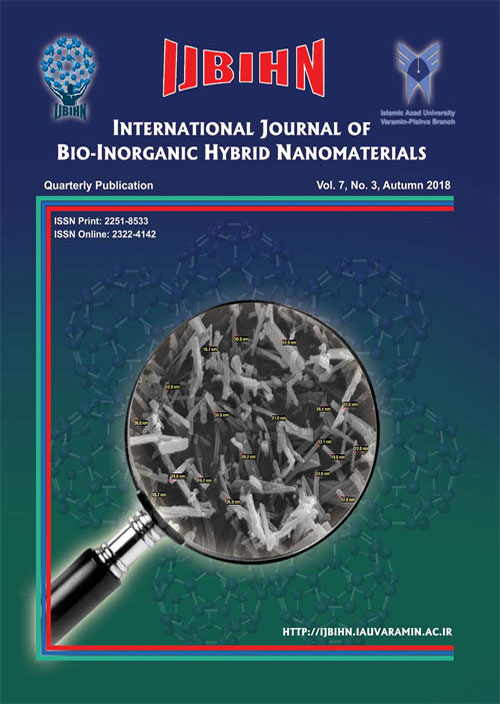فهرست مطالب

International Journal Of Bio-Inorganic Hybrid Nanomaterials
Volume:8 Issue: 1, Spring 2019
- تاریخ انتشار: 1398/02/17
- تعداد عناوین: 6
-
Pages 5-25
Nano-Hydroxyapatite (nHAP) is a very valuable mineral that is widely used in tissueengineering as well as bone and dental repair. Moreover, it is a major component of bone, enamel and dentin that can interact effectively with healing tissues due to its high biocompatibility. It is important to note that the purpose of its medical application can be identified based on the structure and synthesis of HAP. This study aimed to efficiently review all the previously conducted studies on synthesis and application of nHAP over the years of researchers' efforts and present the results for optimizing biocompatible material synthesis.
Keywords: Bone Regeneration, interaction, nHAP, Preparation Methods, structure -
Pages 27-37
In this paper, the novel application of organic/inorganic perovskite hybrid materials isproposed for grid-connected Photo-voltaic (PV) cells. The perovskite hybrid cells attracted a lot of interest due to their potential in combining advantages of both components. Looking to the future, there is no doubt that these new generations of hybrid materials, born from the very fruitful activities in this research field, will open a land of promising applications in many areas such as solar cells and fuel. In other view due to world energy requirements, the integration of solar energy will diminish the consumption rate of non- renewable energies and also dependency of fuel cells. The PV cells are utilized the sun energy and generate the DC power where the converters are utilized for boosting the low output voltage of PV cells and converting the DC to AC grid voltage respectively. The Maximum Power Point Tracking (MPPT) method based on Perturb and Observe (P & O) algorithm is used to operate the PV cell in point of maximum power. The three-phase current source inverter (CSI) as a DC/AC converter is utilized for grid connection of PV. The simulation by MATLAB/SIMULINK is done to show the effectiveness of the proposed method.
Keywords: Converter, grid, MPPT, Perovskite hybrid materials, PV -
Pages 39-45
The work is the report about stearic acid sol-gel synthesis method, magnetically, electricalcharacterization and activation energy of copper manganese oxide nanostructures. The CuMn2O4 nanostructures are synthesized at a temperature of 600°C using the sol-gel method. The structural analysis using X-ray diffraction (XRD) and Scherrer equation show that the crystallite size of CuMn2O4 is about 23.0 nm. The activation energy value is measured by temperature-programmed reduction (TPR) analysis at three heating rates of 10, 15 and 20 °C/min and Kissinger equation .The Ea value is 28.1 kJ/mol. Vibrating sample magnetometer (VSM) analysis of the nanostructures indicates moderateferromagnetic properties. Examination of the dielectric properties by the LCR meter indicates the semiconducting property of the nanostructure. The highest conductivity increase was in the frequency of 308 MHz equal to 70.7 μS. Therefore, the CuMn2O4 nanostructures are potential candidates in fuel cells, telephones, loudspeakers and transformers due to their properties and convenience, non-toxic and environmentally friendly production methods.
Keywords: activation energy, CuMn2O4 Nanostructures, Electrical properties, Ferromagnetism, Kissinger Equation -
Pages 47-52
Investigating the longitudinal optical conductivity of graphene systems, which is the mostimportant property for opto-electronic devices, for three-layer graphene systems theoretically and numerically is the main purpose of this study. Each layer can be mono- or bi-layer graphene. Separation between layers has been denoted by d, selected to be about ten nanometers. The carrier densities in each layer can be tuned by changing gate voltage. In these two dimensional layered structures; the main contributions to the optical conductivity are from the intra- and inter-band transition channels in a same layer. In this paper the graphene structure is described primarily, and the three-layer graphene systems with composes of mono-mono-mono and bi-bi-bi has been defined. Using dielectric and electron density-density correlation tensors, the imaginary part of dielectric function for the three-layer graphene systems are calculated and optical conductivities are plotted as a function of photon energies in different broadening widths, for final stages.
Keywords: Broadening width, Landau level, Optical conductivity, Three- layer Graphene -
Pages 53-57
Carbon nanoscrolls (CNSs) belong to the same class of carbon-based nanomaterialsas carbon nanotubes. As a new category of quasi one dimensional material Graphene Nanoscroll (GNS) has captivated the researchers recently because of its exceptional electronic properties like having large carrier mobility. GNS shape has open edges and no caps unlike Single Wall Nanotubes (SWNTs) which are wound into close cylinders' shape. The carbon atoms on the edge of GNS have two typical topological shapes. GNS can be classified to either AGNS or ZGNS according to its topological structure. However, in this research, only ZGNS was taken into consideration because AGNS behaves as metallic unlike ZGNS which can behave either metallic or semiconducting depends on their chirality which is the main highlight in this project. In this project, the modeling of GNS was done and their electrical characteristic and behavior were investigated. Also by utilizing analytical approach, introduces modeling the quantum current for graphene nanoscroll Furthermore.
Keywords: Armchair GNS, Fermi-Dirac integral, Graphene Nanoscroll, Quantum current, Zigzag GNS -
Pages 59-61
Nano cavities based on silicon and indium phosphide materials have been comparedin this study, considering field intensity enhancement factor. The results of FDTD based simulations declare that the Si nano-cavity improves confined optical field about 7.7 times higher than the InP based nano-cavity. The introduced dielectric nano-cavities support resonance wavelength at about λ=1.55 μm.
Keywords: Enhancement factor, FDTD, Nano cavity, Photonic Crystal

